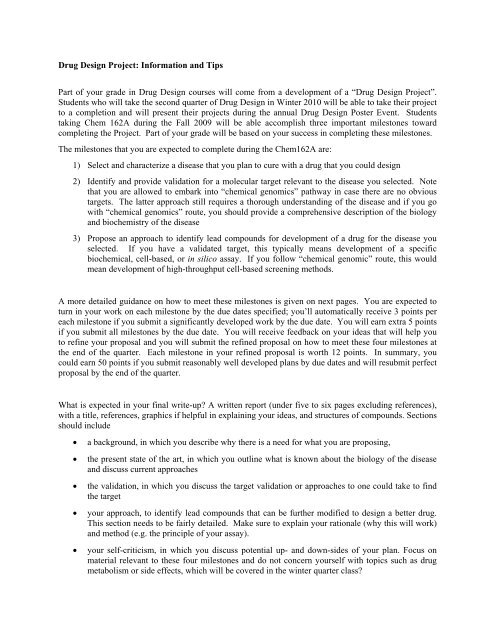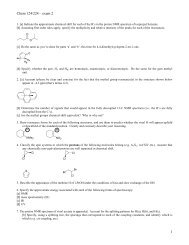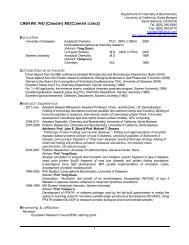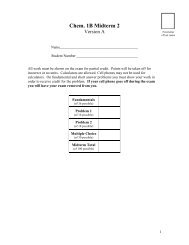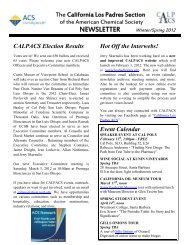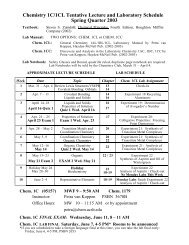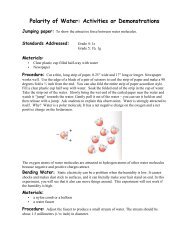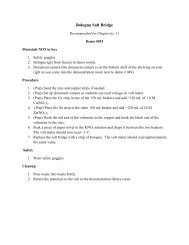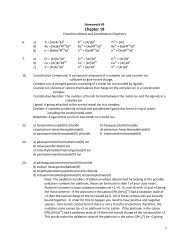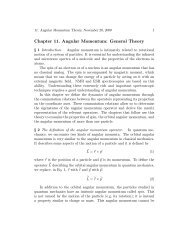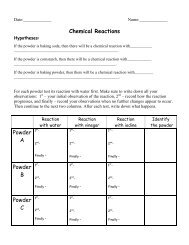Drug Design Project - Department of Chemistry and Biochemistry
Drug Design Project - Department of Chemistry and Biochemistry
Drug Design Project - Department of Chemistry and Biochemistry
Create successful ePaper yourself
Turn your PDF publications into a flip-book with our unique Google optimized e-Paper software.
<strong>Drug</strong> <strong>Design</strong> <strong>Project</strong>: Information <strong>and</strong> Tips<br />
Part <strong>of</strong> your grade in <strong>Drug</strong> <strong>Design</strong> courses will come from a development <strong>of</strong> a “<strong>Drug</strong> <strong>Design</strong> <strong>Project</strong>”.<br />
Students who will take the second quarter <strong>of</strong> <strong>Drug</strong> <strong>Design</strong> in Winter 2010 will be able to take their project<br />
to a completion <strong>and</strong> will present their projects during the annual <strong>Drug</strong> <strong>Design</strong> Poster Event. Students<br />
taking Chem 162A during the Fall 2009 will be able accomplish three important milestones toward<br />
completing the <strong>Project</strong>. Part <strong>of</strong> your grade will be based on your success in completing these milestones.<br />
The milestones that you are expected to complete during the Chem162A are:<br />
1) Select <strong>and</strong> characterize a disease that you plan to cure with a drug that you could design<br />
2) Identify <strong>and</strong> provide validation for a molecular target relevant to the disease you selected. Note<br />
that you are allowed to embark into “chemical genomics” pathway in case there are no obvious<br />
targets. The latter approach still requires a thorough underst<strong>and</strong>ing <strong>of</strong> the disease <strong>and</strong> if you go<br />
with “chemical genomics” route, you should provide a comprehensive description <strong>of</strong> the biology<br />
<strong>and</strong> biochemistry <strong>of</strong> the disease<br />
3) Propose an approach to identify lead compounds for development <strong>of</strong> a drug for the disease you<br />
selected. If you have a validated target, this typically means development <strong>of</strong> a specific<br />
biochemical, cell-based, or in silico assay. If you follow “chemical genomic” route, this would<br />
mean development <strong>of</strong> high-throughput cell-based screening methods.<br />
A more detailed guidance on how to meet these milestones is given on next pages. You are expected to<br />
turn in your work on each milestone by the due dates specified; you’ll automatically receive 3 points per<br />
each milestone if you submit a significantly developed work by the due date. You will earn extra 5 points<br />
if you submit all milestones by the due date. You will receive feedback on your ideas that will help you<br />
to refine your proposal <strong>and</strong> you will submit the refined proposal on how to meet these four milestones at<br />
the end <strong>of</strong> the quarter. Each milestone in your refined proposal is worth 12 points. In summary, you<br />
could earn 50 points if you submit reasonably well developed plans by due dates <strong>and</strong> will resubmit perfect<br />
proposal by the end <strong>of</strong> the quarter.<br />
What is expected in your final write-up A written report (under five to six pages excluding references),<br />
with a title, references, graphics if helpful in explaining your ideas, <strong>and</strong> structures <strong>of</strong> compounds. Sections<br />
should include<br />
• a background, in which you describe why there is a need for what you are proposing,<br />
• the present state <strong>of</strong> the art, in which you outline what is known about the biology <strong>of</strong> the disease<br />
<strong>and</strong> discuss current approaches<br />
• the validation, in which you discuss the target validation or approaches to one could take to find<br />
the target<br />
• your approach, to identify lead compounds that can be further modified to design a better drug.<br />
This section needs to be fairly detailed. Make sure to explain your rationale (why this will work)<br />
<strong>and</strong> method (e.g. the principle <strong>of</strong> your assay).<br />
• your self-criticism, in which you discuss potential up- <strong>and</strong> down-sides <strong>of</strong> your plan. Focus on<br />
material relevant to these four milestones <strong>and</strong> do not concern yourself with topics such as drug<br />
metabolism or side effects, which will be covered in the winter quarter class
<strong>Drug</strong> Development Milestone I<br />
Select <strong>and</strong> characterize a disease that you plan to cure with a drug that you could design<br />
Due date: Wed, Oct 28, 2009<br />
As a first part <strong>of</strong> your project, you are expected to identify a disease that you want to work on. Submit<br />
two-to-three page summary where you discuss the nature <strong>of</strong> the disease, give statistics concerning its<br />
prevalence <strong>and</strong> mortality, <strong>and</strong> discuss current approaches that are used to tackle this disease. Your<br />
discussion <strong>of</strong> the nature <strong>of</strong> the disease should cover both the clinical manifestations (e.g. diphtheria, if<br />
untreated, leads to inflammation <strong>and</strong> eventual failure <strong>of</strong> the heart muscle) <strong>and</strong> important biochemical<br />
mechanisms (e.g. diphtheria toxin inactivates molecules that are critical for protein synthesis by attaching<br />
a ribosyl moiety to them)<br />
How to go about deciding about the disease The first step is to select a general area <strong>of</strong> drug application.<br />
Perhaps you know <strong>of</strong> a disease someone has for which the treatment is less than optimal. For example,<br />
side effects may be quite bad. Another approach is to identify an area that is broadly acknowledged as<br />
being in need <strong>of</strong> further improvement. One example is the treatment <strong>of</strong> infectious diseases (e.g., TB) that<br />
because <strong>of</strong> resistance development within the microbial strains, is in dire need <strong>of</strong> improvement. Cancer<br />
<strong>and</strong> virally transmitted diseases are some <strong>of</strong> the bigger unsolved areas. However, many less "visible"<br />
areas are interesting too. Aging. Allergic rhinitis. Sleeping sickness. Hair loss. The list goes on. You<br />
could browse journals such as the Journal <strong>of</strong> Medicinal <strong>Chemistry</strong>, <strong>Biochemistry</strong>, Science, Nature, or<br />
Molecular Pharmacology to get an idea what people are working on. And <strong>of</strong> course, use the Web. Pick<br />
something that you will find fun <strong>and</strong> learn from. However, you need to remember that you need to come<br />
up with a reasonable proposal. Diseases that have not been sufficiently characterized, or diseases that are<br />
known to arise from a variety <strong>of</strong> molecular mechanisms might be too difficult for your project. As you<br />
read the literature, you will quickly develop a feeling if the disease is sufficiently well understood.<br />
Students in the course may work alone or form a team <strong>of</strong> two when working on their project. If you feel<br />
confident in your ability to tackle such a problem alone go on with the disease <strong>of</strong> your choice. If you feel<br />
that you could benefit form a formal partnership with another student, team up. However, students who<br />
team up cannot pick their own project but shall work on one <strong>of</strong> the “feature projects” listed below.<br />
Students who work alone are allowed to work independently on the “feature projects”. No more than one<br />
team can work on a particular feature project.<br />
Feature projects:<br />
• Altzheimer’s disease<br />
• Avian influenza<br />
• Breast cancer<br />
• Diabetes mellitus type 2<br />
• Hepatitis C<br />
• High pain sensitivity / chronic pain<br />
• Metastasis <strong>of</strong> tumor cells (i.e. focus on preventing the attachment <strong>of</strong> circulating tumor cells in<br />
other tissues)<br />
• Multiple sclerosis<br />
• Tuberculosis
<strong>Drug</strong> Development Milestone II<br />
Due date: Fri, Nov 13, 2009<br />
Validate one target for a disease that you plan to cure with a drug that you could design<br />
As a second part <strong>of</strong> your project, you are expected to validate one target pertaining to the disease that you<br />
want to work on. As part <strong>of</strong> your second assignment, present <strong>and</strong> critically discuss the evidence that<br />
validates your target(s). Make sure to read <strong>and</strong> reference the original research that provided validating<br />
data, <strong>and</strong> discuss limitations <strong>of</strong> such studies. For most targets, a thorough validation can be concisely<br />
written up into about one-page essay but you are allowed to be longer if necessary.<br />
Remember some <strong>of</strong> the key messages from the validation exercise you did earlier:<br />
1) You need to work through a lot <strong>of</strong> literature. I anticipate that a good answer will involve a few<br />
review papers <strong>and</strong> several original research reports. You actually need to read <strong>and</strong> partially<br />
underst<strong>and</strong> these, not just quote them because they were mentioned in the review papers. When<br />
reading complex research papers, you may want to follow the order<br />
a) Abstract (tells you if this is a relevant paper)<br />
b) Introduction (if well written, gives good background <strong>and</strong> pointers to earlier works)<br />
c) Discussion <strong>and</strong> conclusions (hopefully explains what was found)<br />
d) Results (do you really agree with their interpretation <strong>of</strong> what was observed)<br />
e) Methods (get the general idea what approach was used, do not worry about details)<br />
You may find that an old publication provides key data that validates the target but you still need<br />
to check more recent works for additional evidence. You will not be excused if you build your<br />
drug design project around on a target that is known to be invalid.<br />
2) Having a clinically efficient drug that binds to the target does not necessarily validate the target.<br />
3) Not every paper that deals with curing a disease is about target validation. Evaluate each paper<br />
critically; do not just believe the hype authors are giving.<br />
4) Keep in mind that for the success in your project your target has to be druggable. So, while one<br />
might argue that chromosome 21 is a valid target for Down’s syndrome; it is not druggable based<br />
on our current technologies. Do not pick targets that require you to invent a time-machine, nanorobot,<br />
or Maxwell daemon for treating the disease.<br />
Some students may wish to work on a project where the target is unknown. For example, you may have<br />
heard or read about a surprisingly valuable side-effect <strong>of</strong> a currently existing drug <strong>and</strong> want to design a<br />
combinatorial library around this structure to find compounds that show a stronger “side-effect”. In this<br />
case, please describe what approaches you would take to identify the target <strong>of</strong> your drug. As this is<br />
(bio)chemistry class, your approach must be based on biochemistry <strong>and</strong> molecular biology methods.<br />
If your target is not previously validated, you should pursue validation approaches that are available to<br />
you (SNP <strong>and</strong> microarray analysis). You need provide significant level <strong>of</strong> detail here; answers like “I<br />
will validate the target through SNP analysis” are not worth much. Analyzing some publicly available<br />
microarray (e.g. from http://www.ebi.ac.uk/microarray-as/ae/) or SNP data is an appropriate way to show<br />
that you know how to validate a target even if your conclusions may be statistically weak. Note that the<br />
databases typically carry fragment names (such as 205225_at) <strong>and</strong> you need to use Stanford Source to<br />
reveal the corresponding protein name (estrogen receptor 1).
<strong>Drug</strong> Development Milestone III<br />
Due date: Monday, Nov 30, 2009<br />
As a third part <strong>of</strong> your project, you are expected to come up with a plan how to identify potential drug<br />
c<strong>and</strong>idates for the disease you are working on. If you have a validated target, this typically means<br />
development <strong>of</strong> a specific biochemical assay. If you follow “chemical genomic” route, this would mean<br />
development <strong>of</strong> high-throughput cell-based screening methods.<br />
Please discuss what the rationale behind using such an assay is, describe the assay in detail, <strong>and</strong> identify<br />
any potential limitations. Your assay can be molecular-biology based (e.g. quantification <strong>of</strong> particular<br />
mRNA using molecular beacons), biochemical (e.g. measuring lig<strong>and</strong> binding to the receptor), cell-based<br />
(e.g. monitoring the formation <strong>of</strong> a fluorescent reaction product in live cells), histological (analysis <strong>of</strong><br />
tissue appearance), clinical (determination <strong>of</strong> viral load), or end-point assay (improvement in host health).<br />
In any case, create at least one image that illustrates the principle behind the assay. You should create the<br />
image yourself; the image you create may be based on existing images that depict this assay.<br />
The lecture material should give you a good starting point <strong>and</strong> may be sufficient in simple scenarios, such<br />
as in vitro identification <strong>of</strong> agonists for nicotinic acetylcholine receptor. You most likely need to work<br />
with scientific literature in order to best to decide which particular approach is most appropriate. Original<br />
research papers also allow you to learn more about details <strong>of</strong> specific assays. It is a good practice, but not<br />
an absolute requirement to hunt down the original research in which the assay was developed or applied<br />
to your target. For some more pioneering projects such papers may not simply exist; it is sufficient that<br />
you provide evidence that a particular assay or animal model is appropriate to your target <strong>and</strong> disease.<br />
If your approach is more “me-too”, where you are hoping to improve on already existing known bioactive<br />
molecule, you do not need to design a high-throughput assay. It is sufficient to describe an assay that<br />
allows measuring the activity <strong>of</strong> your lead compound <strong>and</strong> its analogs. If your approach is “me-too”, then<br />
it is critical that you identify the limitations <strong>of</strong> the lead, identify the pharmacophore <strong>and</strong> auxotrophic<br />
groups, <strong>and</strong> propose structure-activity studies. You may propose rational, lig<strong>and</strong>-based design<br />
approaches to optimize your target or perform a QSAR analysis <strong>of</strong> a set <strong>of</strong> known biologically active<br />
molecules in order to find more potent ones.<br />
Keep in mind that we are not talking about human clinical trials here yet but at most well-characterized<br />
animal models <strong>of</strong> the disease.<br />
Be specific about where your collection <strong>of</strong> molecules to be screened comes from. If you are proposing to<br />
identify a truly novel compound, it is sufficient to state that you are using some existing library, <strong>and</strong><br />
characterize this briefly. If you are proposing a “me-too” approach based on a known lead compound,<br />
provide a synthetic route that allows preparing a combinatorial library <strong>of</strong> such analogs.<br />
You may propose virtual screening as an additional assay if the structure <strong>of</strong> your validated target is<br />
known <strong>and</strong> available. The advantage <strong>of</strong> this approach is that you will be able to carry out the virtual<br />
screening in the CHEM162B course. However, because we have not covered this approach this quarter, it<br />
cannot be your main assay.


